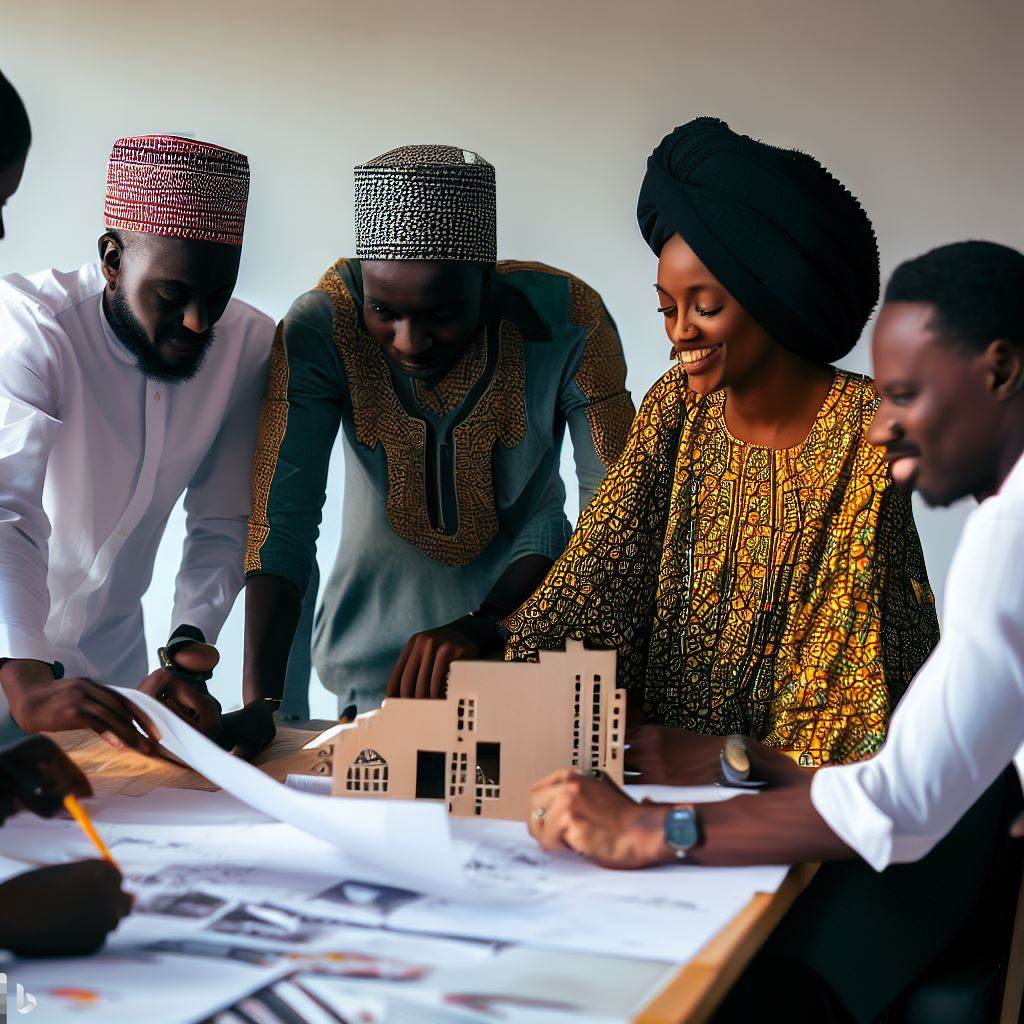Introduction
Climate change is no longer a distant threat but a reality that has become increasingly evident in our everyday lives. The consequences of climate change are felt all around the world, and developing countries like Nigeria are particularly vulnerable.
As such, it is essential that we take measures to mitigate the impact of climate change, and this includes the role of architecture. In this blog post, we’ll explore how Nigerian architecture responds to climate change and the importance of this topic.
Architecture is a significant contributor to global carbon emissions, accounting for nearly 40% of all energy use. Nigerian architecture is no exception and has a responsibility to reduce its impact on the planet.
As Nigeria continues to grow and develop, finding ways to reduce the carbon footprint of its architecture is critical.
Additionally, climate change is expected to have far-reaching impacts on Nigeria, from hotter temperatures to more frequent flooding.
The infrastructure and buildings in Nigeria must be designed to withstand these changes and prevent additional damage to the environment.
In essence, addressing climate change is essential to ensure the future of our planet, and architecture plays a significant role in this effort.
As we delve into how Nigerian architecture responds to climate change, we’ll see that there is much to be learned and applied globally.
Read: A Tour of Nigeria’s Most Iconic Architectural Structures
Climate Change in Nigeria
Nigeria, like many other countries in the world, is experiencing the effects of climate change.
Climate change refers to a long-term shift in weather patterns, such as temperature, precipitation, and wind. In Nigeria, this shift is having significant impacts on the environment and people.
Overview of Climate Change in Nigeria
According to research conducted by the Nigerian Meteorological Agency, the country is experiencing a rise in temperature of about 0.06°C per decade.
This change is more pronounced in the northern part of the country. Additionally, the country is experiencing reduced rainfall, especially in the southern regions.
Effects of Climate Change on the Environment and People
Climate change is having significant impacts on the environment and people in Nigeria. Here are some of the effects:
- Water Scarcity: With the reduced rainfall and the drying up of water bodies, there is a shortage of water in many parts of Nigeria. This has led to conflicts between communities over access to water.
- Agriculture: The changing climate has had a significant impact on agriculture in Nigeria. The reduction in rainfall has led to low crop yields, while the rise in temperature has led to the spread of pests and diseases.
- Health: Climate change has also had an impact on the health of people in Nigeria. The rise in temperature has led to an increase in the incidence of malaria and other diseases.
- Flooding: In recent years, Nigeria has experienced severe flooding, which has caused significant damage to infrastructure and displacement of people.
In response to these challenges, the Nigerian government is taking steps to mitigate the effects of climate change. One of the areas that have received significant attention is architecture.
How Nigerian Architecture Responds to Climate Change
Nigerian architects are increasingly incorporating sustainable features into their designs to respond to the challenges of climate change. Here are some of the ways Nigerian architecture is responding to climate change:
- Passive Design: Nigerian architects are focusing on passive design strategies that reduce the need for artificial heating and cooling. These strategies include maximizing natural light and ventilation, as well as using materials that can regulate temperature.
- Green Design: Green design features, such as green roofs and walls, are becoming more common in Nigerian architecture. These features help to mitigate the urban heat island effect and provide additional insulation.
- Water Management: Nigerian architects are incorporating water management features into their designs, such as rainwater harvesting and water-efficient fixtures. These strategies help to conserve water and reduce the impact of drought.
- Renewable Energy: Nigerian architects are increasingly incorporating renewable energy sources into their designs. Solar panels, wind turbines, and biomass energy are becoming more common in new buildings.
In summary, climate change is a pressing issue in Nigeria, and it is having significant impacts on the environment and people.
However, Nigerian architects are responding to this challenge by incorporating sustainable features into their designs.
By doing so, they are helping to mitigate the effects of climate change and create a more sustainable built environment.
Read: Innovation in Nigeria: Highlighting Futuristic Architecture
Traditional Nigerian Architecture
Nigeria has a rich cultural heritage, and its architectural designs reflect the diversity of its people.
Traditional Nigerian architecture has evolved over time, and it is characterized by a combination of practicality, functionality, and beauty.
This architecture is a product of its environment and climate, and it is developed in a way that responds to the local conditions and weather patterns.
Features of Traditional Nigerian architecture
- Use of locally sourced materials: Traditional Nigerian architecture relies on materials that are readily available in the local environment. These include clay, mud, wood, and thatch.
- Flat roofs and thick walls: To protect against sunlight, the walls of traditional Nigerian buildings are thicker. The roofs are flat to facilitate rainwater harvesting.
- Courtyards and open spaces: Most traditional Nigerian buildings have courtyards or open spaces to facilitate ventilation and cooling.
- Ornate designs: Nigerian architecture is known for its ornate designs, especially in the forms of carvings and patterns that are present in the walls, doors, and roofs.
How traditional Nigerian architecture responds to the climate
Designers optimize traditional Nigerian architecture for local weather patterns, using materials to withstand the harsh climate.
What’s more, traditional Nigerian architecture utilizes passive cooling techniques to create a comfortable living environment.
Passive cooling techniques
Passive cooling techniques cool buildings without energy-intensive air conditioning. Traditional Nigerian architecture achieves this through various methods, including:
- Courtyards and open spaces: Courtyards and open spaces facilitate airflow, and they create natural ventilation that cools the building.
- Roof designs: Roofs are flat, and they have overhangs that provide shade from direct sunlight. The flat roofs also facilitate rainwater harvesting.
- Orientation: Buildings are oriented to take advantage of natural wind patterns, and they are positioned to receive adequate sunlight.
- Thick walls: Thick walls provide thermal mass, which helps to regulate the internal temperature of the building.
Therefore, traditional Nigerian architecture is an excellent example of how architecture can respond to the climate.
Designers consider local weather patterns, incorporating passive cooling techniques for comfortable living environments in buildings.
Traditional Nigerian architecture reflects cultural heritage with functional beauty and ornate designs.
Designers consider local weather patterns, incorporating passive cooling techniques for comfortable living environments in buildings.
Traditional Nigerian architecture reflects cultural heritage with functional beauty and ornate designs.
Read: Breaking into the Architecture Scene of Nigeria: A Guide
Modern Nigerian Architecture
When it comes to modern architecture in Nigeria, there are some specific characteristics that define it.
- Clean lines and minimalism are common features
- The use of contemporary building materials like glass, steel, and concrete is popular
- Innovative design concepts and technological advances are frequently incorporated
- Functionality and efficiency are prioritized over aesthetics alone
So how does this type of architecture respond to climate change in Nigeria?
- Many modern buildings are designed to be energy-efficient, using materials that provide insulation from extreme temperatures
- Incorporating natural ventilation systems is also common to reduce reliance on artificial cooling
- Sustainable practices like rainwater harvesting and solar technology are integrated into building designs
- Using appropriate landscaping can help with temperature regulation and reducing heat island effects in urban areas
By prioritizing these features and practices in modern architecture, Nigeria can address the challenges of climate change while also contributing to a more sustainable future.
Read: Dissecting The Architect Registration Council of Nigeria
Sustainable Building Techniques
Sustainable building techniques are a critical aspect of Nigerian architecture’s response to climate change.
As our planet faces an increasing number of environmental challenges, sustainable building practices offer an effective way to reduce negative human impacts on the environment.
Use of Sustainable Building Materials
In Nigerian architecture, sustainable building materials are widely used for their eco-friendliness, durability, and low maintenance. These materials reduce waste and save costs by being recyclable or reusable.
Examples of sustainable building materials include:
- Bamboo – A fast-growing, renewable resource that is widely available in Nigeria.
- Recycled plastic – Recycled plastic materials can be used in various construction applications, reducing the amount of plastic waste in the environment.
- Reclaimed wood – Reclaimed wood can be used for flooring, furniture, and other structures, reducing the need for new timber.
Energy-Efficient Designs
Nigerian architecture responds to climate change by incorporating energy-efficient designs that minimize the use of energy-intensive appliances and lighting.
Buildings with efficient designs require less energy to maintain comfortable indoor conditions and help to reduce greenhouse gas emissions.
Examples of energy-efficient design features include:
- Passive solar heating – Nigerian architects use building orientation, window placement, and shading to maximize the use of natural sunlight for heating and lighting.
- Green roofs – Green roofs are vegetated roofs that help to lower building temperatures, reduce energy consumption, and filter stormwater runoff.
- Solar panels – Solar panels generate electricity from sunlight, reducing reliance on fossil fuel energy sources.
Water Conservation Techniques
Water is a precious resource in Nigeria, and sustainable building techniques that conserve water are critical to mitigating the impact of climate change.
By implementing water conservation techniques, Nigerian architects can reduce water consumption and protect the environment.
Examples of water conservation techniques include:
- Low-flow fixtures – Low-flow toilets, showerheads, and faucets reduce water usage and save on monthly water bills.
- Greywater systems – Greywater systems reuse water from sinks, showers, and washing machines for landscape irrigation, reducing the demand for fresh water.
- Rainwater harvesting – Nigerian architects design buildings with rainwater collection systems that collect rainwater runoff for non-potable water needs, such as toilet flushing or irrigation.
Overall, sustainable building techniques are essential for Nigerian architecture to respond effectively to climate change.
By using sustainable building materials, energy-efficient designs, and water conservation techniques, we can minimize our carbon footprint, conserve natural resources, and create a more sustainable environment for future generations.

Case Studies
Nigeria is a country with diverse climatic zones and varying weather patterns.
Buildings in Nigeria have to be designed to respond to these variations. Below are some examples of buildings in Nigeria that respond to climate change.
- The Nigerian Institute of Architects Headquarters in Abuja – The building has a solid concrete roof that protects the interior from the sun’s rays.
It also has an open courtyard that cools the building by allowing air to circulate freely. This helps to reduce the need for air conditioning, which in turn reduces energy consumption. - The Lekki Conservation Centre in Lagos – The centre was designed to blend in with the surrounding flora and fauna, and to use natural resources for cooling and ventilation.
The building has curved walls that provide shade and reduce the amount of direct sunlight entering the interior. It also uses natural ventilation to cool the interior spaces. - The Cocoon Tower in Lagos – This tower is designed to reduce energy consumption through the use of natural day lighting and ventilation.
The building has a double skin façade with external movable sunshades that keep the interior cool and reduce the need for air conditioning. The internal façade is also designed to allow for natural ventilation.
These buildings have several advantages. One of the most significant advantages is energy efficiency.
They consume less energy for cooling and ventilation, which in turn reduces carbon emissions from power generation. They also reduce the environmental impact of building construction and use, which is critical in the fight against climate change.
Another advantage is comfort and wellness. These buildings provide a comfortable indoor environment that promotes wellness and productivity. Natural light and ventilation have been shown to improve mental and physical health and enhance well-being.
In addition to the above buildings, Nigerian architects are also exploring other innovative building technologies and materials that respond to climate change.
These include green roofs, sustainable materials, rainwater harvesting systems, and renewable energy systems.
Essentially, the case studies highlighted above demonstrate that Nigerian architecture is responding to climate change through innovative design solutions and technologies.
These buildings not only reduce energy consumption but also promote wellness and productivity.
As Nigeria continues to experience the effects of climate change, architects and building designers must continue to develop sustainable solutions that respond to the local climate and reduce the environmental impact of building construction and use.
Read: The Financial Perspective: Architect Salaries in Nigeria
Challenges and Opportunities
- Developing climate-responsive architecture presents several challenges in Nigeria.
- The biggest challenge is the lack of awareness and understanding of climate change and its impact on buildings.
- There is also a shortage of trained professionals who can design and implement climate-responsive architecture.
- The high cost of building materials and construction processes is another issue that architects and builders face.
- Inadequate government policies and regulations on sustainable building practices hinder the development of climate-responsive architecture.
- Architects, engineers, and government bodies must collaborate and communicate for constructing climate-responsive buildings.
Despite these challenges, there are numerous opportunities for improving climate-responsive architecture in Nigeria.
- Education and awareness campaigns can help to promote the benefits of climate-responsive design and construction practices.
- There is a need for collaboration and partnerships between architects, engineers, and government agencies to create effective policies and regulations for sustainable building practices.
- Greater use of local and natural materials can reduce the cost of construction and make buildings more sustainable.
- Innovations in technology can facilitate the design and construction of climate-responsive buildings.
- Additionally, there is a growing interest in eco-tourism in Nigeria, which presents an opportunity for the development of sustainable architecture.
- Finally, the global trend towards sustainable and eco-friendly buildings can create new markets for Nigerian architects and builders who specialize in climate-responsive design.
Overall, developing climate-responsive architecture in Nigeria is not without challenges, but there are also numerous opportunities for improving sustainable building practices.
Raising awareness and promoting collaboration among stakeholders in the construction industry can lead to more climate-responsive buildings that are cost-effective, energy-efficient, and environmentally friendly.
Conclusion
Nigerian architecture has shown a promising response to the challenges of climate change.
Architects have started incorporating various strategies to mitigate the negative impacts of changing weather patterns, such as natural ventilation, shading, and the use of local materials.
However, there is still room for improvement. The increasing demand for modern buildings often leads to unsustainable practices, such as the use of energy-intensive materials and HVAC systems.
To ensure a sustainable future, architects, government officials, and developers must work together to implement environmentally responsive designs and construction methods.
We cannot afford to ignore the threat of climate change and its devastating effects any longer.
It is time to take responsibility for our actions and work towards more sustainable practices in Nigerian architecture. Let us all take a step towards a more sustainable future, one building at a time.




